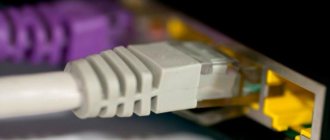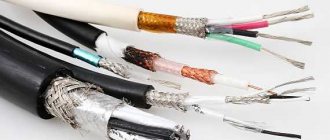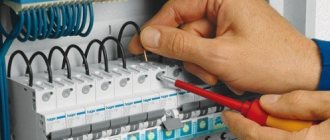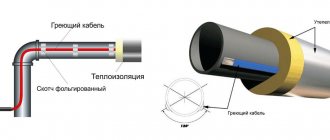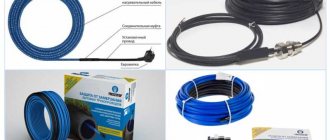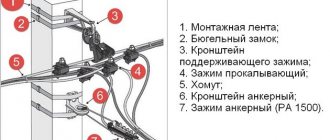Decorative lighting using LED strips has come into fashion relatively recently. Many users have not yet had time to understand the specifics of operation and the features of connecting lamps. In particular, not everyone can choose the right cable for an LED strip. This is an important issue, since an incorrect connection can cause the backlight to fail.
Permissible LED strip supply voltage
Most LED strips are powered by a 12 volt DC source. There are samples designed for 24 or 48 V. In addition, there are LED strips that are directly connected to the 220 V AC mains. All necessary parameters are indicated on the packaging or on the backing of the lamp. It is necessary to understand that the requirements for low-voltage strips are much higher than for 220 V lamps.
For connection, a special strip power supply is used that meets the requirements of the lamp. The power supply mode for LEDs does not allow exceeding the nominal values. This will cause severe overheating and increased degradation of the LED elements. If the voltage is lower, the brightness of the glow decreases. Therefore, it is important to organize the supply of rated current to the contacts of the LED strip. It has been experimentally determined that most LED strips can operate at a 10% undervoltage, but reducing it further excessively reduces the brightness of the glow.
Installation location
There is no need to hide power supplies in places where there will be no access after the repair is completed.
We are talking about plasterboard-covered and suspended ceilings. The fact is that the power supply is the same consumable material as a lamp for any lamp.
And sooner or later it will have to be changed. In fact, the power supply is one of the weakest links in the entire backlight. Therefore, make sure you have access to it in advance.
Choosing a cable for diode strip
It is often necessary to place the driver at a great distance from the tape itself. This occurs when creating illumination for advertising structures, interiors and other three-dimensional objects. Sometimes the voltage supplied to the input does not match the output of the power supply. This is due to the fact that the cross-section of the wire is too small; due to the long length, a voltage drop occurs. Therefore, it is necessary to first calculate the cross-section of the wire and select the most suitable sample.
LED strips that are directly connected to a 220 V network require installation of protection. At the same time, you need to understand that the main indicator is the current strength. The easiest way is to follow the generally accepted relationships:
| Current strength | Cable cross-section |
| 6 A | 0.5 mm2 |
| 10 A | 0.75 mm2 |
| 14 A | 1 mm2 |
| 15 A | 1.5 mm2 |
| 19 A | 2 mm2 |
| 21 A | 2.5 mm2 |
Additional sensor functionality: 5 important points
This device has a variety of activations. It may also have additional features. With certain skills, a homemade sensor can be equipped with a good range of functions. Today, similar switches are produced with the following versions of added functions:
- Remote control. It greatly facilitates control over the light spectrum of multi-color tape. In this case, the use of a controller is mandatory. Otherwise the remote control will not work. The remote control is also good at controlling sconces. And when connecting to a tape, the remote control must be selected in tandem with the controller.
- Timer. Thanks to this device, significant energy savings can be achieved. In the timer, you can set the time to turn off the lights when there are no people in the room or in the house.
- Volume response. This product reacts even to light contact. Often this device is made independently and complements the timer.
- View without contact. The reaction of these devices occurs when the situation in the room somehow changes. These may be different movements, temperature and lighting changes.
- Dimmer. Any designated touch strip devices can be equipped with a dimmer. This addition allows you to control the brightness of the light in the room.
Optimal for a residential apartment is 1 netxt LED lamp with a touch switch. But it is not prohibited to work on modern electrics with your own hands. More on this below.
Installation and soldering of wires
Installation and connection of the LED strip cable must be done carefully, observing the polarity and manufacturer's recommendations. Compliance with the operating mode of the tape and its service life depend on the quality of the connections. For connection, you can use a standard LED connector, which allows you to quickly and efficiently assemble all the lighting. Its advantages are:
- ease of use - no preliminary preparation is required to work with such devices;
- high assembly speed;
- no tools needed;
- If errors are made during the connection, redoing the connection is easy and quick.
Important! However, mechanical connectors oxidize over time and no longer provide a quality connection. Therefore, experts recommend using soldering. It requires a soldering iron, solder and flux. It is necessary to have some skill in such work, otherwise there is a risk of shorting the contacts or overheating the tape.
Power supply placement
The power supply should be as close as possible to the LED strip. Problems often arise with this, since load-bearing surfaces rarely allow for discreet placement of the device. Sometimes you have to stretch a low-voltage line over a long distance. Experts do not recommend making a cable longer than 35 m, as its resistance will be too high. Many users solve the problem differently - they hide the driver in the supporting structure, behind protrusions or in recesses.
The cable is routed to the block, and the low-voltage line is made as short as possible. This option is most common. The only drawback is the need to run a long wire under high voltage, which is not always convenient or safe.
Video description
The correct switch for the LED strip.
Mini motion sensor
The device is designed to work together with 12 V light sources with a power of up to 36 W Source foton.ua
You can also install a miniature motion sensor as a switch in the profile of the LED strip. The difference between this device and a contactless switch lies in the range of response to movement - here it increases to two to three meters. That is, when you enter the room, the tape will begin to gradually gain brightness with a delay of up to 5 seconds (the time is set by the manufacturer). Such devices are mounted not only in the profile of the tape, but also in baseboards, fillets, kitchen wall furniture, etc.
Main conclusions
Selecting a cable for an LED strip is an important and necessary procedure. It allows you to improve the glow mode of the tape and extend the service life of the backlight. The correct choice of cable is made according to the following criteria:
- current consumption;
- voltage drop;
- installation and connection conditions.
Calculating the cable cross-section is not difficult, but there is an easier way. You need to find one of the online calculators on the Internet and use it for quick and accurate calculations.
Explain your methods for determining the cable parameters for an LED strip in the comments.
Design features
Any model consists of:
- Front panel. For ease of use, it is often equipped with backlighting. May have different shapes and designs. When choosing a suitable model, many people pay attention to it without delving into the operating principle and functionality of the device as a whole;
- A touch sensor that sends control signals to the device when an external influence occurs;
- A switching circuit, with the help of which an external signal is converted into the electric current necessary to ensure the operation of the tape;
- A body that combines all of the above elements into a single whole. The design of the housing may vary. It can be built-in or overhead. Its type has a direct impact on the order of installation work.
Attention! The service life of a particular device directly depends on the quality of its components.
Which to choose
A large selection of touch switches causes certain difficulties in selecting the optimal option. Such products are boards with average dimensions of 40 × 10 × 2 mm, allowing them to fit into an LED profile, external modules placed in a plastic case, or a controller equipped with a remote control.
We advise you to pay attention to the wireless pass-through switch, which is also convenient to use, especially when lighting long corridors. By turning the light on at the beginning, you can turn it off at the end.
To choose the appropriate option, you must first decide on the type of LED switch. After this, it is worth considering the technical specifications. Noteworthy meaning:
- The voltage that is supplied to the input of the device and created at its output;
- The strength of the current flowing through the device in standby mode and generated when the load is connected;
- Power.
If you decide to install a monochrome LED strip, you should decide on the operating principle of the circuit breaker. Manufacturers offer devices:
- Capacitive, inside of which there is a spring that fits tightly to the plate. When your hand touches the switch, it creates a vibration. As a result, the contact closes and the lighting turns on. However, having decided to opt for such a device, it is worth considering that if the thickness of the plexiglass diffuser is more than 1 mm, you may encounter a lack of operation. This will cause serious inconvenience during operation;
- Infrared, triggered every time there is an object at a distance of 10 cm from the surface, from which the signal is reflected and returns to the receiving element. If the gap between the protective screen and the sensitive element exceeds 5 mm, you will have to use a profile with a shallower depth or take care of the presence of a hole in the light-scattering lens.
If the choice is made in favor of a model with a dimmer, you should also decide on the principle of operation. Such touch switches are most often turned on/off by a short touch. To change the brightness, you need to hold your hand longer on the control panel.
Some models have a slightly different operating principle. They can have several pre-programmed operating modes. Similar devices are suitable for RBG tapes. They are equipped with a control panel equipped with a touch ring. To change the shade of the glow, you need to smoothly move your finger along the spectral circle. As a result, diodes of the selected color or a combination of them will be switched on.
Attention! When choosing a switch, pay attention to the frequency of the PWM pulses. It should be more than 300 Hz so as not to have a negative effect on vision and the nervous system.
Types of switches
Switches offered by manufacturers are divided into various groups depending on:
- Control method. They can be mechanical, electronic or remotely operated;
- Installation method. Some models are mounted directly into the aluminum profile of the lighting fixture, others are model or overhead;
- Connection type. There are pass-through and non-pass-through devices. The main advantage of the first type is the ability to turn on/off the lighting system from different places. The second type can be controlled from one specific location.
All products differ in shape, color and texture of the front panel. This allows you to choose the best option, taking into account the overall stylistic design of the room.
A modern touch switch has a number of additional functions. Such devices may have:
- Remote control with IR sensor. It becomes possible to control the controller and RGB strip. The user chooses the backlight color that he likes best;
- Timer. Functional models that allow you to optimize energy costs. With this function, the user has the ability to configure time intervals when the lighting system operates;
- A non-contact system that responds to changes in ambient temperature, a sharp sound, or is triggered when moving objects are within a given radius;
- Dimmer. A functional element that allows you to change the brightness of the LED strip. Brightness control is carried out within a specified range. Light intensity can be changed in the range from 10% to 100%;
- Capacitive response. This element allows you to increase the sensitivity of the panel.
Attention! Touch switches can be activated when you approach the sensor and after direct contact with your fingers. The latter type is most widespread.

